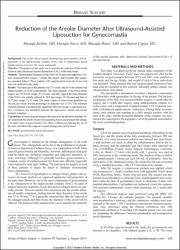| dc.contributor.author | Keskin, Mustafa | |
| dc.contributor.author | Sütçü, Mustafa | |
| dc.contributor.author | Hancı, Mustafa | |
| dc.contributor.author | Çiğsar, Bülent | |
| dc.date.accessioned | 10.07.201910:49:13 | |
| dc.date.accessioned | 2019-07-10T19:35:28Z | |
| dc.date.available | 10.07.201910:49:14 | |
| dc.date.available | 2019-07-10T19:35:28Z | |
| dc.date.issued | 2017 | en_US |
| dc.identifier.citation | Keskin, M., Sütçü, M., Hancı, M. ve Çiğsar, B. (2017). Reduction of the areolar diameter after ultrasound-assisted liposuction for gynecomastia. Annals of Plastic Surgery, 79(2), 135-138. https://dx.doi.org/10.1097/SAP.0000000000000994 | en_US |
| dc.identifier.issn | 0148-7043 | |
| dc.identifier.issn | 1536-3708 | |
| dc.identifier.uri | https://hdl.handle.net/20.500.12511/799 | |
| dc.identifier.uri | https://dx.doi.org/10.1097/SAP.0000000000000994 | |
| dc.description.abstract | Background: One of the clinical aspects characterizing gynecomastia is the enlargement of the nipple-areolar complex (NAC) due to hypertrophic breast glands, and the excessive fatty tissue underneath. Objective: The purpose of this study was to quantify the reduction of the areolar diameter after ultrasound-assisted liposuction (UAL) of the male breast. Methods: The horizontal diameters of the NACs of 30 men who underwent UAL were measured before surgery, 1 month after surgery and 6 months after surgery in a standard fashion. Those patients with surgical gland removals of any kind were not included in this study. Results: The mean age of the patients was 27.9 years, and all of the patients had bilateral grade I, II, or III gynecomastia. The mean diameter of the NACs before surgery was 35.36 mm (range, 26-55 mm), and after surgery, the mean diameter of the NACs was initially reduced to 28.8 mm (range, 23-44 mm) and later to 28.57 mm (range, 23-42 mm). The mean volume of breast tissue aspirated was 382 mL per breast, and the percentage of reduction was 17.3%. The reduction of areola diameter was statistically significant after first month. A significant positive correlation was identified between the liposuction volume and areolar diameter reduction. Conclusions: In cases of gynecomastia, the removal of the glandular and fatty tissue underneath the areola releases the expanding forces and pressure that enlarge it. In many cases of gynecomastia, UAL alone is effective in reducing the size of the NAC and allows the surgeon to avoid placing scars on the breast. | en_US |
| dc.language.iso | eng | en_US |
| dc.publisher | Lippincott Williams and Wilkins | en_US |
| dc.rights | info:eu-repo/semantics/embargoedAccess | en_US |
| dc.subject | Areola | en_US |
| dc.subject | Gynecomastia | en_US |
| dc.subject | Liposuction | en_US |
| dc.title | Reduction of the areolar diameter after ultrasound-assisted liposuction for gynecomastia | en_US |
| dc.type | article | en_US |
| dc.relation.ispartof | Annals of Plastic Surgery | en_US |
| dc.department | İstanbul Medipol Üniversitesi, Tıp Fakültesi, Cerrahi Tıp Bilimleri Bölümü, Plastik, Rekonstrüktif ve Estetik Cerrahi Ana Bilim Dalı | en_US |
| dc.authorid | 0000-0003-2066-7454 | en_US |
| dc.authorid | 0000-0001-5106-0159 | en_US |
| dc.identifier.volume | 79 | en_US |
| dc.identifier.issue | 2 | en_US |
| dc.identifier.startpage | 135 | en_US |
| dc.identifier.endpage | 138 | en_US |
| dc.relation.publicationcategory | Makale - Uluslararası Hakemli Dergi - Kurum Öğretim Elemanı | en_US |
| dc.identifier.doi | 10.1097/SAP.0000000000000994 | en_US |
| dc.identifier.wosquality | Q4 | en_US |
| dc.identifier.scopusquality | Q1 | en_US |


















